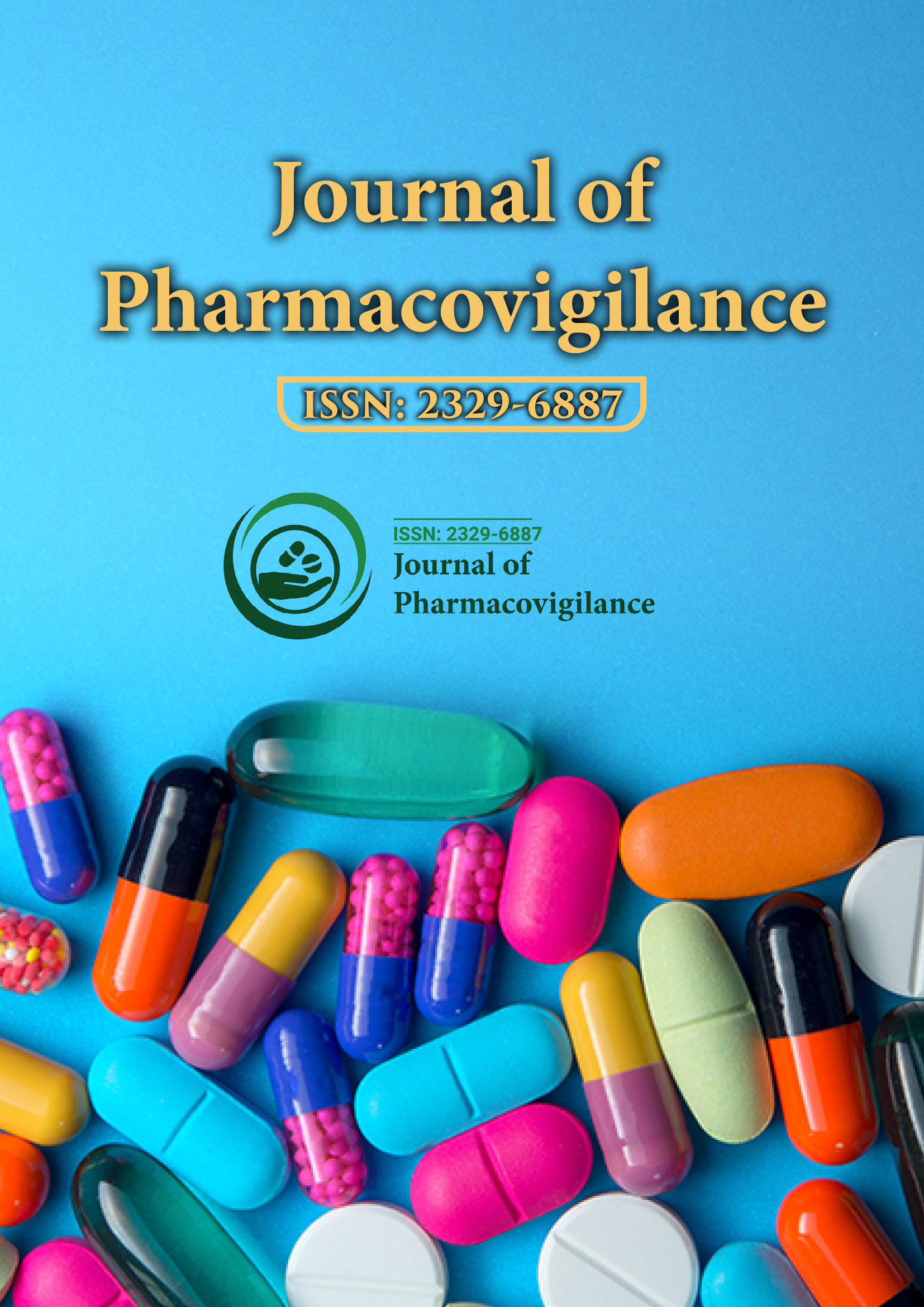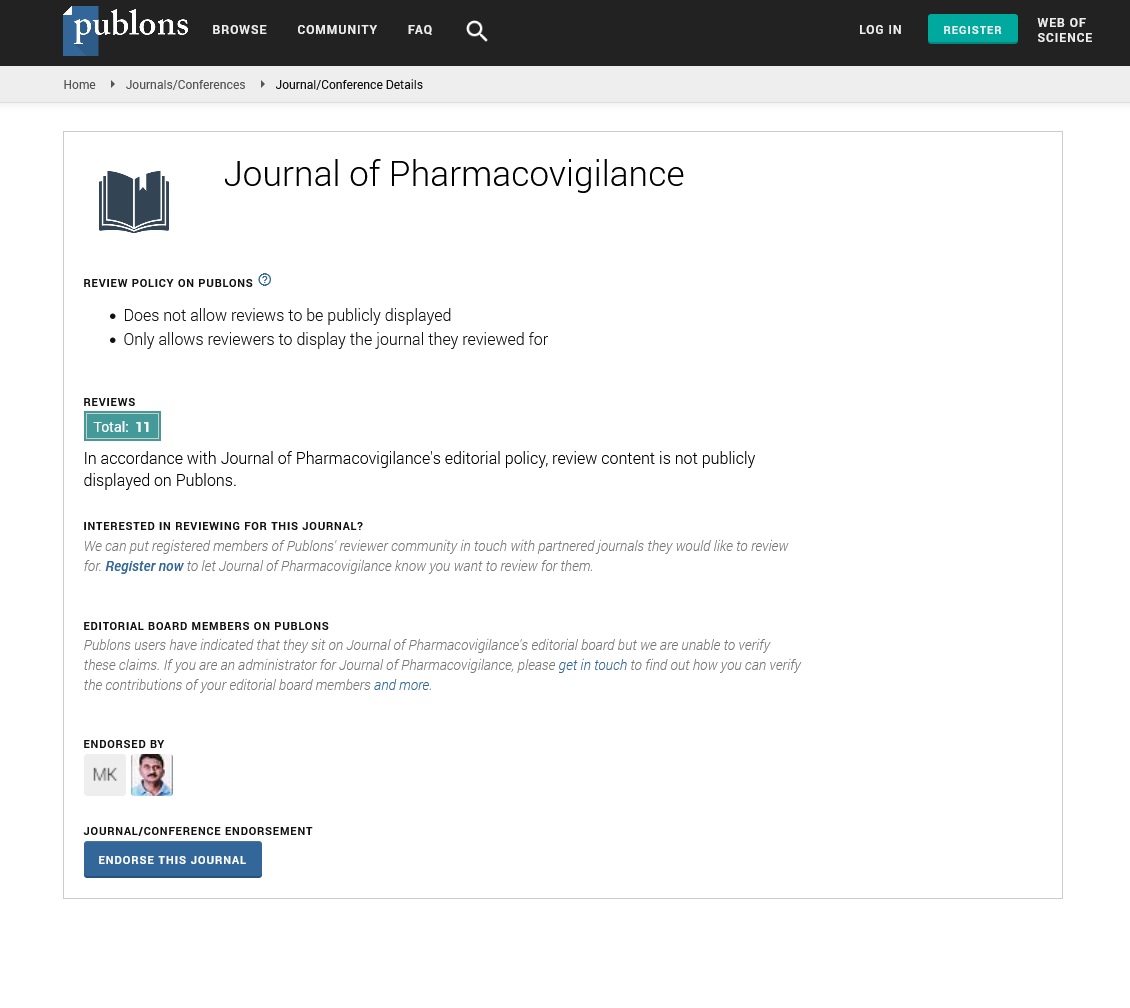Indexed In
- Open J Gate
- JournalTOCs
- The Global Impact Factor (GIF)
- RefSeek
- Hamdard University
- EBSCO A-Z
- OCLC- WorldCat
- Publons
- Euro Pub
- Google Scholar
Useful Links
Share This Page
Journal Flyer

Open Access Journals
- Agri and Aquaculture
- Biochemistry
- Bioinformatics & Systems Biology
- Business & Management
- Chemistry
- Clinical Sciences
- Engineering
- Food & Nutrition
- General Science
- Genetics & Molecular Biology
- Immunology & Microbiology
- Medical Sciences
- Neuroscience & Psychology
- Nursing & Health Care
- Pharmaceutical Sciences
Articles published in Journal of Pharmacovigilance have been cited by esteemed scholars and scientists all around the world. Journal of Pharmacovigilance has got h-index 25, which means every article in Journal of Pharmacovigilance has got 25 average citations.
Following are the list of articles that have cited the articles published in Journal of Pharmacovigilance.
| 2024 | 2023 | 2022 | 2021 | 2020 | 2019 | 2018 | 2017 | 2016 | 2015 | 2014 | 2013 | |
|---|---|---|---|---|---|---|---|---|---|---|---|---|
Total published articles |
37 | 57 | 61 | 61 | 17 | 5 | 26 | 31 | 56 | 62 | 50 | 30 |
Research, Review articles and Editorials |
0 | 1 | 8 | 27 | 11 | 5 | 16 | 25 | 46 | 45 | 36 | 26 |
Research communications, Review communications, Editorial communications, Case reports and Commentary |
31 | 56 | 53 | 34 | 6 | 0 | 10 | 6 | 10 | 17 | 14 | 4 |
Conference proceedings |
0 | 7 | 0 | 0 | 0 | 0 | 30 | 50 | 94 | 70 | 201 | 73 |
Citations received as per Google Scholar, other indexing platforms and portals |
151 | 216 | 237 | 311 | 270 | 254 | 238 | 198 | 319 | 91 | 48 | 18 |
| Journal total citations count | 2408 |
| Journal impact factor | 1.71 |
| Journal 5 years impact factor | 1.79 |
| Journal cite score | 12.14 |
| Journal h-index | 25 |
Important citations
Sekhon BS (2013) Repositioning drugs and biologics: Retargeting old/existing drugs for potential new therapeutic applications. Journal of Pharmaceutical Education and Research 4: 1.
Amarendra KE (2016) Overview of Pharmacovigilance. j Pharmacol Toxicol Stu 4: 125-133.
Joubert MC, Naidoo P (2016) Knowledge, perceptions and practices of pharmacovigilance amongst community and hospital pharmacists in a selected district of North West Province, South Africa. health sa gesondheid. 2016 Dec 31;21:238-44.
Krasko MP, Kraydashenko OJ, Kremzer OO, Krasko explosives (2016) Clinical pharmacology in rheumatology and farmakoteriapiya.
Amarendra KE (2016) Overview of Pharmacovigilance. j Pharmacol Toxicol Stu 4: 125-133.
Amarendra KE (2016) Overview of Pharmacovigilance. j Pharmacol Toxicol Stu 4: 125-133.
Khusro A, Aarti C, Agastian P (2016) Anti-tubercular peptides: A quest of future therapeutic weapon to combat tuberculosis. Asian Pacific Journal of Tropical Medicine 9: 1023-1034.
Tejada FR, Walk AR, Kharel MK (2015) Drugs Used in Tuberculosis and Leprosy. Side Effects of Drugs Annual 37: 349-365.
Chuemongkon W, Daungru N (2014) Azithromycin and the risk of coronary artery diseases. Journal of Medicine and Health Science 21:32-38.
Amarendra KE (2016) Overview of Pharmacovigilance. j Pharmacol Toxicol Stu 4: 125-133.
Jaiswal P (2014) A Review on Adverse Drug Events to Create Awareness. J Pharmacovigi.
Yildirim P, Bloice M, Holzinger A (2014) Knowledge Discovery and Visualization of Clusters for Erythromycin Related Adverse Events in the FDA Drug Adverse Event Reporting System. In Interactive Knowledge Discovery and Data Mining in Biomedical Informatics, Springer Berlin Heidelberg 101-116.
Raschi E, Poluzzi E, Salvo F, Koci A, Suling M, et al. (2016) The contribution of national spontaneous reporting systems to detect signals of torsadogenicity: issues emerging from the ARITMO Project. Drug safety 39: 59-68.
Hancox JC, Hasnain M, Vieweg WV, Gysel M, Methot M, et al. (2014) Erythromycin, QTc interval prolongation, and torsade de pointes: Case reports, major risk factors and illness severity. Therapeutic advances in infectious disease 2: 47-59.
Vieweg WV, Hancox JC, Hasnain M, Koneru JN, Gysel M, et al. (2013) Clarithromycin, QTc interval prolongation and torsades de pointes: the need to study case reports. Therapeutic advances in infectious disease 1: 121-138.
Giudicessi JR, Ackerman MJ (2013) Azithromycin and risk of sudden cardiac death: guilty as charged or falsely accused?. Cleveland Clinic journal of medicine 80: 539.
Raschi E, Poluzzi E, Godman B, Koci A, Moretti U, et al. (2013) Torsadogenic risk of antipsychotics: combining adverse event reports with drug utilization data across Europe. PLoS One 8: e81208.
Albert RK, Schuller JL (2014) Macrolide antibiotics and the risk of cardiac arrhythmias. American journal of respiratory and critical care medicine 189: 1173-1180.
Kaya D, Sürmelioğlu N, Karata Y (2016) Arsiv Kaynak Tarama Dergisi.
Mihalić M (2016) Doprinos novoga farmakovigilancijskoga zakonodavstva EU-a u zaštiti zdravlja (Doctoral dissertation, University of Zagreb. Faculty of Pharmacy and Biochemistry.).

